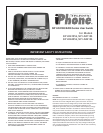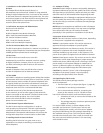5.4 Three-Way Conference Calls
The SIP LD series supports three-way conference calling. The
CONF or FLASH key allows the user to include two
other parties in a three-way conversation. One three-way
conference could be done using only one line or both lines.
5.4.1 Initiating a Three-Way Conference Call With One Line
1. Place or receive the first call.
2. Press FLASH.
3. Dial the third party, and wait for them to answer.
4. Press FLASH again to join all three callers.
5. To disconnect the third party and return to a two-party
call, press FLASH again.
5.4.2 Initiating a Three-Way Conference Call With Two Lines
1. Place or receive the first call.
2. Place that call on hold by pressing the HOLD key.
3. Press LINE 2, and place or receive the second call.
4. Press the CONF key to join all three callers.
ADVANCED FEATURES
5.5 Using Voice Mail
5.5.1 Message Waiting
If the red message waiting indicator is flashing slowly, voice
mail messages are waiting to be retrieved.
5.5.2 Retrieving Messages
Press the MESSAGE key. The speakerphone will be activated
(unless the handset is off-hook) and the phone calls the
voice mail server. Follow the voice prompts for entering
your password, listening to, saving and deleting messages.
When all unheard messages have been listened to or
deleted, the message waiting light will turn off.
NOTE: Message waiting number must be pre-configured
before using this feature. (Refer to subsection 3.2.3)
6. Care and Troubleshooting
Your Teledex SIP LD series IP phone will provide years of
trouble-free service, particularly if it is maintained in an
indoor environment.
6.1 Cleaning the SIP LD Series
Dust or deposited materials caused by normal handling of
the phone handset or base should be removed occasionally
to ensure optimal performance. Use a soft cloth moistened
with water to wipe the plastic exterior parts.
CAUTION: Do not use solvents, powders or spray
cleansers that may leak into the electronic components
and cause damage.
6.2 In Case of Trouble
If the SIP LD series does not seem to function as
expected, there are several troubleshooting techniques
that may be tried before calling the network administrator.
6.2.1 Disconnect From the Network
Unplug the network cable from the wall jack. Wait at least
fifteen (15) seconds, then plug the cable back into the same
jack. The phone will attempt to re-establish contact with the
IP-PBX. In many cases, this will restore normal operation.
WARNING: Risk of electrical shock! Dangerous voltages may
be present on the exposed terminals of the network patch
cable after it is plugged into the network wall jack.
6.2.2 Disconnect the PC
If there is a PC or other network device connected to the port
on the side of the phone, disconnect the cable to the PC or
device from the base, then perform the actions from section
6.2.1 (Disconnect From the Network).
6.2.3 Check the Cords and Cables
If the previous two steps do not solve the problem, all of
the cords and cables (including handset cord and headsets)
should be disconnected, inspected for dirt or corrosion,
and reconnected.
7. Appendix A – European Requirements
This product complies with the following CE requirements:
89/336/EEC EN 55024
EN 55022 EN 60950 (CB SCHEME)
8. Appendix B – SIP LD Series Product Specifications
TELEPHONE TYPE
Two-line, Voice over Internet Protocol network terminal
Call Manager Protocol
SIP (Session Initiation Protocol)
Dial Keypad
12 keys: Numeric 1 – 9, 0, *, #
Capable of DTMF signaling
Speed (Memory) Dialing Keys
SIP LD4105S and SIP LD4205S: 5 keys
SIP LD4110S and SIP LD4210S: 10 keys
Line Keys
Hold, Line 1, Line 2, Conference, Mute, Speaker
Function Keys
Messages, Volume (Up/Down), Soft keys on sccreen
LEDs: Message Waiting, Line 1, Line 2, Conference, Mute,
Speaker
Network Connection
Ethernet 10/100BaseT, RJ-45 connector, 2 ports
(One supporting PoE)
Uplink to network and switch
Pass-through, switched, for local PC
Audio Input/Output
Handset (included), RJ-10 connector
Microphone (built-in)
Speaker (built-in)
9












